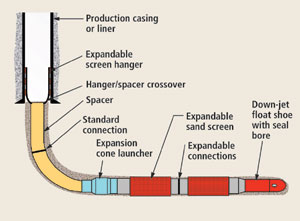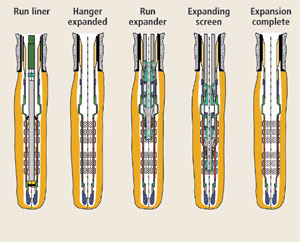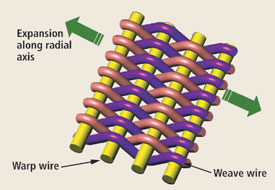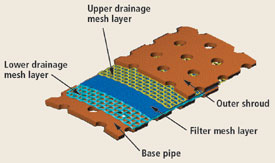Completion Technology
Expandable screen completions successfully installed in offshore wells
These screens perform better than conventional completions in some wells. That’s why expandable sand screen use is growing rapidly
The completions – all of which occurred during the past year – were in several production wells and went according to plans. These occurred in the Gulf of Mexico for Amerada Hess in cased hole, and in open hole for CNOOC (formerly YPF Repsol Maxus, Southeast Sumatra), offshore Indonesia. The new system used Halliburton Energy Services' PoroFlex* expandable sand screen completion system. This article describes the technology, its installation and benefits to operators.
SYSTEM BENEFITS
The expandable system was designed with these major benefits in mind:
- Eliminate or reduce borehole/screen annulus.
- Minimize plugging of non-uniform sands.
- Minimize pressure drops in horizontal intervals.
- Reduce or eliminate gravel pack failures.
- Bolster collapse resistance and broaden remedial completion options through the use of perforated, solid base pipe.
- Save rig time by faster makeup with threaded connections, plus flexibility to rotate and wash the screen to bottom during installation.
- Improve long-term sand-control reliability provided by a one-piece, diffusion bonded laminate, expandable filtration media.
- Lower risk by reducing pipe-weight requirements to expand the screen through use of hydraulic expansion, also allowing expansion in wellbores where it is not possible to apply excessive set-down weight at the expansion face.
SYSTEM FEATURES
The system comprises the following components (Fig. 1):
- Expandable screen suspension tool – A bi-directional device that anchors the screen in the production casing while providing a reliable annular barrier.
- Suspension tool to spacer pipe crossover – allows the transition between the hanger and completion equipment.
- Spacer pipe: 5.750-in. OD – Used to initialize the screen expansion tool. Does not require expansion.
- Screen joints – Expandable screen assemblies comprised of perforated base pipe, premium screen jackets, and integral joint threaded connections.
- Seal bore – Run below the last screen or spacer joint, the unexpanded seal bore can be used to retract the expansion cone to its retrieval position.
- Float shoe – Run below the seal bore, the unexpanded float shoe closes the toe of the completion.
 |
Fig. 1. Expandable screen system components.
|
|
The system uses Grant-Prideco XPC-GII expandable connections. This is the same connection developed for and used by Enventure in its solid expandable tubular product, with the exception that the seal ring is removed.
The screen can be expanded in two ways: mechanically (Fig. 2.) and hydraulically, the preferred method. After expanding the screen hanger, mechanical expansion is possible if sufficient mechanical force can be delivered to the expansion cone. Otherwise, to expand the screen hydraulically, slips are anchored above the expansion cone, allowing the expansion mandrel to extend, forcing the expansion cone downhole, which expands the base pipe and screen.
 |
Fig. 2. Operating steps for screen installation and mechanical expansion.
|
|
The standard expansion tool can deliver up to 10-ft expansion strokes; however, stroke length can be increased in 10-ft increments. At the end of each stroke, the slips are released and the power section of the expansion tool is lowered meet the expansion cone. At this point, the slips are set and the expansion cycle begins again. Since screen is expanded from the top down the expansion tool can be retrieved from the well in the event that expansion prematurely ceases for whatever reason.
The type of weave and the method of construction make possible the same pre- and post-expansion screen rating. The pore size is determined by the diameter of the warp (larger) wire. Expansion does not take the weave (smaller) wires significantly beyond their yield point. Thus, no appreciable diameter change takes place, so the screen micron rating is unchanged, Fig. 3.
 |
Fig. 3. Micron rating determined by warp wire diameter, since warp wires are not expanded and weave wires are not yielded.
|
|
For 6 1/8 in., the flow area through the screen is 26% and the base pipe has a 6% open area. To maximize collapse resistance, the system uses perforated pipe. This configuration, along with a diffusion bonded screen section, which includes a perforated outer shroud, also gives the product more stiffness, Fig. 4. This helps get the assembly to bottom and through any tight spots that might be encountered. Means to increase the base-pipe flow area are being investigated.
 |
Fig. 4. Screen construction. The top four layers are sintered together to form a one-piece filter.
|
|
Although the system is primarily for open-hole horizontal completions requiring sand control, it can be used in cased-hole applications. Unlike open-hole completion, production velocity through perforations can easily damage screens. In either case, the candidate well must be analyzed to ensure that an expandable screen installation is the right choice, rather than a gravel pack or stand-alone screen completion.
SCREEN INSTALLATIONS
In all of the following installations, standard service alloy base pipe with 316L filtration media was used with a screen run-in ID of 4.5 in. (5.375 OD). Expanded ID and OD were 5.44 in. and 6 1/8 in., respectively, see Table 1.
| |
Significant data for the alloy system:* |
|
| |
|
6.125-in.
system |
8.500-in.
system |
|
| |
Screen |
|
|
|
| |
Screen rating (m) |
125/250 |
125 |
|
| |
Run-in OD (125m /250m) (in.) |
5.375/5.460 |
7.370 |
|
| |
Run-in ID (in.) |
4.500 |
6.390 |
|
| |
Expanded OD (in.) |
6.125 |
8.500 |
|
| |
Expanded ID (in.) |
5.440 |
7.730 |
|
| |
Screen material |
316L |
316L |
|
| |
Service rating |
Standard & H2S |
|
| |
Expansion Tool |
|
|
| |
Run in and retrieval OD (in.) |
5.000 |
7.000 |
|
| |
Expanded OD (in.) |
5.440 |
7.730 |
|
| |
Operating pressure (psi) |
3,500 |
TBD |
|
| |
Expansion method |
Mechanical or Hydraulic |
|
| |
Stroke length (ft) |
10 |
15 |
|
| |
*13Cr equivalent CRA material is currently being qualified. |
|
|
A dual completion took place at the Breton Sound 51-1 well in the Gulf of Mexico for Amerada Hess in cased hole. The maximum hole angle was 53° in a 7-in., 29 lb/ft casing. The upper zone, located at 8,558-ft MD, was completed with one joint of screen along with a 10-ft cased-hole annular barrier tool (comprised of perforated pipe onto which is bonded a proprietary pattern of Nitrile elastomer). The lower zone, 11,440-ft MD, was completed using one joint of screen with a seal bore/float shoe at the toe. Amerada Hess said that the job went according to plan. The cost savings were not as good as expected, in part because of the learning curve that was needed to handle the new technology – gaining experience was also part of the reason for using it. The well has, to date, produced about 160,000 bbl of oil and 110 MMcfg – on par with expectations, and there has not been any sand produced.
There were two completions offshore Indonesia for CNOOC. Both were set in 6 1/8-in. open-hole side tracks. The first was a dual zone completion with a maximum hole angle of 57°. Approximately 100 ft of total expansion (two joints of screen with an annular barrier tool in between) was performed. The second well was a single zone open hole horizontal completion set at 6,200 ft. A total of 288 ft of screen was expanded. Both CNOOC installations were performed per plan and procedure.
No failures occurred during installation or expansion of the base pipe, screen, or expandable connection. Additional cased- and open-hole installations of the 6 1/8 in. PoroFlex system are scheduled for early 2003 in Brunei, Nigeria and Brazil, with expansion intervals in excess of 1,000 ft. 
|






